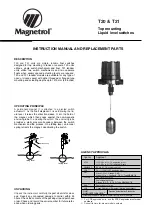
– 332 –
C
HAPTER
14
| Security Measures
Configuring 802.1X Port Authentication
C
ONFIGURING
P
ORT
S
ETTINGS FOR
802.1X
Use the Security > Port Authentication (Configure Interface) page to
configure 802.1X port settings for the switch as the local authenticator.
When 802.1X is enabled, you need to configure the parameters for the
authentication process that runs between the client and the switch (i.e.,
authenticator), as well as the client identity lookup process that runs
between the switch and authentication server.
CLI R
EFERENCES
◆
"802.1X Port Authentication" on page 741
C
OMMAND
U
SAGE
When the switch functions as a local authenticator between supplicant
devices attached to the switch and the authentication server, configure the
parameters for the exchange of EAP messages between the authenticator
and clients.
P
ARAMETERS
These parameters are displayed in the web interface:
◆
Port
– Port number.
◆
Status
– Indicates if authentication is enabled or disabled on the port.
The status is disabled if the control mode is set to Force-Authorized.
◆
Authorized
– Displays the 802.1X authorization status of connected
clients.
■
Yes
– Connected client is authorized.
■
No
– Connected client is not authorized.
◆
Supplicant
– Indicates the MAC address of a connected client.
◆
Control Mode
– Sets the authentication mode to one of the following
options:
■
Auto
– Requires a dot1x-aware client to be authorized by the
authentication server. Clients that are not dot1x-aware will be
denied access.
■
Force-Authorized
– Forces the port to grant access to all clients,
either dot1x-aware or otherwise. (This is the default setting.)
■
Force-Unauthorized
– Forces the port to deny access to all
clients, either dot1x-aware or otherwise.
◆
Operation Mode
– Allows single or multiple hosts (clients) to connect
to an 802.1X-authorized port. (Default: Single-Host)
■
Single-Host
– Allows only a single host to connect to this port.
■
Multi-Host
– Allows multiple host to connect to this port.
Summary of Contents for LGB6026A
Page 6: ...ABOUT THIS GUIDE 4...
Page 40: ...38 CONTENTS...
Page 60: ...58 SECTION I Getting Started...
Page 86: ...84 SECTION II Web Configuration Unicast Routing on page 517 Multicast Routing on page 575...
Page 162: ...160 CHAPTER 5 Interface Configuration VLAN Trunking...
Page 196: ...194 CHAPTER 6 VLAN Configuration Configuring MAC based VLANs...
Page 204: ...CHAPTER 7 Address Table Settings Clearing the Dynamic Address Table 202...
Page 238: ...CHAPTER 11 Class of Service Layer 2 Queue Settings 236...
Page 254: ...252 CHAPTER 12 Quality of Service Attaching a Policy Map to a Port...
Page 448: ...446 CHAPTER 16 Multicast Filtering Multicast VLAN Registration...
Page 470: ...468 CHAPTER 17 IP Configuration Setting the Switch s IP Address IP Version 6...
Page 576: ...574 CHAPTER 21 Unicast Routing Configuring the Open Shortest Path First Protocol Version 2...
Page 606: ...604 CHAPTER 22 Multicast Routing Configuring PIMv6 for IPv6...
Page 620: ...618 CHAPTER 23 Using the Command Line Interface CLI Command Groups...
Page 672: ...670 CHAPTER 25 System Management Commands Time Range...
Page 692: ...690 CHAPTER 26 SNMP Commands...
Page 700: ...698 CHAPTER 27 Remote Monitoring Commands...
Page 854: ...CHAPTER 34 Port Mirroring Commands Local Port Mirroring Commands 852...
Page 862: ...860 CHAPTER 36 Address Table Commands...
Page 958: ...956 CHAPTER 40 Quality of Service Commands...
Page 1034: ...1032 CHAPTER 42 LLDP Commands...
Page 1044: ...1042 CHAPTER 43 Domain Name Service Commands...
Page 1062: ...1060 CHAPTER 44 DHCP Commands DHCP Server...
Page 1206: ...CHAPTER 47 IP Routing Commands Open Shortest Path First OSPFv3 1204...
Page 1250: ...1248 SECTION IV Appendices...
Page 1256: ...1254 APPENDIX A Software Specifications Management Information Bases...
Page 1278: ...1276 COMMAND LIST...
















































